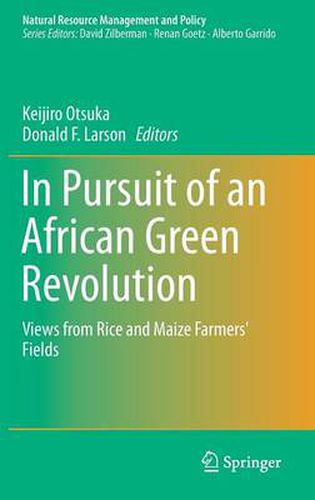Readings Newsletter
Become a Readings Member to make your shopping experience even easier.
Sign in or sign up for free!
You’re not far away from qualifying for FREE standard shipping within Australia
You’ve qualified for FREE standard shipping within Australia
The cart is loading…






This title is printed to order. This book may have been self-published. If so, we cannot guarantee the quality of the content. In the main most books will have gone through the editing process however some may not. We therefore suggest that you be aware of this before ordering this book. If in doubt check either the author or publisher’s details as we are unable to accept any returns unless they are faulty. Please contact us if you have any questions.
This book explores recent experiences in the effort to bring about a Green Revolution in Sub-Saharan Africa (SSA). The chapters focus on rice and maize, which are promising and strategic smallholder crops. Significantly, we find that an African Rice Revolution has already begun in many irrigated areas, using Asian-type modern varieties, chemical fertilizer, and improved management practices. Further, we find that the same technological package significantly increases the productivity and profitability of rice farming in rainfed areas as well. We also find evidence that that management training, when done well, can boost productivity on smallholder farms. This suggests that African governments can accelerate the pace of Africa’s Rice Revolution by strengthening extension capacity.
The story for maize is wholly different, where most farmers use local varieties, apply little chemical fertilizer, and obtain very low yields. However, in the highly populated highlands of Kenya, a number of farmers have adopted high-yielding hybrid maize varieties and chemical fertilizer, as was the case in the Asian Green Revolution, apply manure produced by stall-fed cows, as was the case during the British Agricultural Revolution, and keep improved cows or cross-breeds from European cows and local stock, as was the case of the Indian White Revolution. We conclude that while rice in Africa has benefited from an Asian Green Revolution strategy that emphasizes modern seeds, inputs, and focused knowledge transfers, the success of Africa’s Maize Revolution will require a different system approach based on hybrid maize, chemical and organic fertilizers, and stall-fed cross-bred cows.
$9.00 standard shipping within Australia
FREE standard shipping within Australia for orders over $100.00
Express & International shipping calculated at checkout
This title is printed to order. This book may have been self-published. If so, we cannot guarantee the quality of the content. In the main most books will have gone through the editing process however some may not. We therefore suggest that you be aware of this before ordering this book. If in doubt check either the author or publisher’s details as we are unable to accept any returns unless they are faulty. Please contact us if you have any questions.
This book explores recent experiences in the effort to bring about a Green Revolution in Sub-Saharan Africa (SSA). The chapters focus on rice and maize, which are promising and strategic smallholder crops. Significantly, we find that an African Rice Revolution has already begun in many irrigated areas, using Asian-type modern varieties, chemical fertilizer, and improved management practices. Further, we find that the same technological package significantly increases the productivity and profitability of rice farming in rainfed areas as well. We also find evidence that that management training, when done well, can boost productivity on smallholder farms. This suggests that African governments can accelerate the pace of Africa’s Rice Revolution by strengthening extension capacity.
The story for maize is wholly different, where most farmers use local varieties, apply little chemical fertilizer, and obtain very low yields. However, in the highly populated highlands of Kenya, a number of farmers have adopted high-yielding hybrid maize varieties and chemical fertilizer, as was the case in the Asian Green Revolution, apply manure produced by stall-fed cows, as was the case during the British Agricultural Revolution, and keep improved cows or cross-breeds from European cows and local stock, as was the case of the Indian White Revolution. We conclude that while rice in Africa has benefited from an Asian Green Revolution strategy that emphasizes modern seeds, inputs, and focused knowledge transfers, the success of Africa’s Maize Revolution will require a different system approach based on hybrid maize, chemical and organic fertilizers, and stall-fed cross-bred cows.